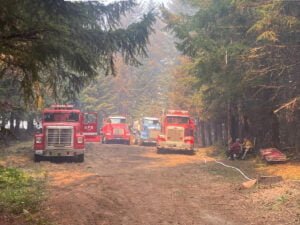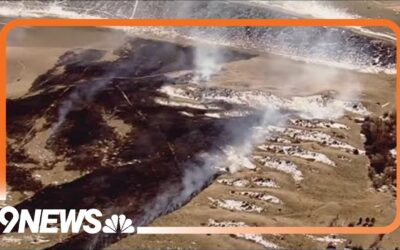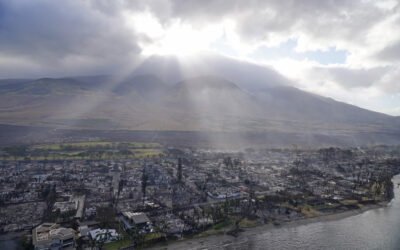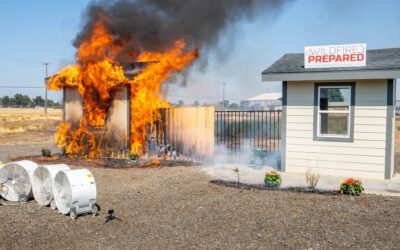
Fire operations near the handline and hose lay areas where firefighters are working on containment lines. Credit: Rainey, tanker operator with Ecological Fire Solutions LLC working on Kalama Fire. (Via Inciweb)
Oct. 12—WASHINGTON STATE — There are six large fires in Washington according to the Northwest Interagency Coordination Center as of Oct. 12.
“It may be October, but it’s clear we’re not out of the woods when it comes to wildfire smoke and the dangers it can bring,” said Kaitlyn Kelly, Air Quality Policy Specialist in a release by the Washington Department of Health.
The NICC defines a large fire as any wildland fire in timber 100 acres or greater, and 300 acres or greater in grasslands/rangelands, or that has an Incident Management Team assigned to it.
There are six fires currently on the Northwest Large Fire Interactive Web Map:
- Kalama: Located 27 miles northeast of Kalama, started on Sept. 1, 9% contained, 461 acres burned.
- Goat Rocks: Located 7 miles east of Packwood, started on Aug. 9, 1% contained, 5,040 acres burned.
- Bolt Creek: Located 37 miles east of Seattle, Started on Sept. 10, 36% contained, 13,500 acres burned.
- Minnow Ridge: Located 25 miles north of Wenatchee, started on Sept. 10, 0% contained, 3,253 acres burned
- White River: Located 14 miles northwest of Plains, started on Aug. 11, 10% contained, 5,359 acres burned
- Nakia Creek: Located 9 miles northeast of Camas, started on Oct. 9, 10% contained, 190 acres burned.
A release by the Washington Department of Health states wildfire smoke will likely linger across Washington into the weekend and that there are ways for residents to be proactive and take steps to protect themselves from smoke.
The DOH stated in the release that it is important to avoid smoke exposure as much as possible because breathing in smoke is not good for anyone and days of consistent smoke exposure can take a toll on one’s health.
“While some parts of the state are experiencing unhealthy levels of air quality, we’re also worried about the impacts of lower levels of smoke for extended periods of time,” said Kelly. “Don’t wait until you start feeling symptoms to act.”
The release asks residents to do their best to stay indoors but if residents must be outside, limit physical activity and wear a properly fitted, NIOSH-approved particulate respirator, such as an N95 mask.
Residents can keep air clean in their homes by closing windows and doors when possible, filtering indoor air, not adding to indoor air pollution with things such as smoking or burning candles and setting air conditioning units to recirculate.
The release also states that during smoke events it’s also important to check on elderly loved ones and neighbors and keep pets indoors and those with pre-existing conditions are often affected the most.
Some symptoms of smoke exposure include:
Minor symptoms include eye, nose, and throat irritation, headaches, wheezing, coughing, and shortness of breath.
More serious symptoms include difficulty breathing, chest pain, and irregular heartbeat. Wildfire smoke can lead to hospitalization and death.
The DOH advises residents to seek medical attention if their symptoms are severe.
Rebecca Pettingill may be reached at [email protected].
___(c)2022 the Columbia Basin Herald, Wash.
Visit the Columbia Basin Herald, Wash. at www.columbiabasinherald.com
Distributed by Tribune Content Agency, LLC.




